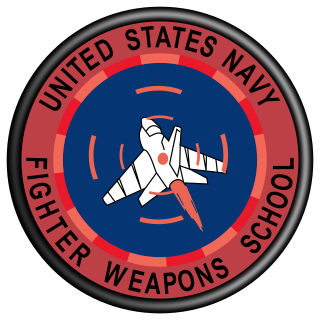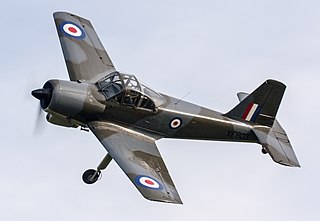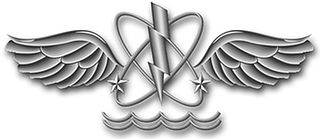Line-oriented flight training (or LOFT) is training in a simulator with a complete crew using representative flight segments that contain normal, abnormal, and emergency procedures that may be expected in line operations. An instructor will monitor the crew's performance and review the simulated flight or flights with the crew afterwards to point out errors or good decisions that were made. [1]
LOFT instructors and crews use LOFT debriefings to analyze and evaluate their performance during training. For LOFT debriefings to improve crew performance, instructors must be effective facilitators. [2] [3]

The Avro Anson is a British twin-engined, multi-role aircraft built by the aircraft manufacturer Avro. Large numbers of the type served in a variety of roles for the Royal Air Force (RAF), Fleet Air Arm (FAA), Royal Canadian Air Force (RCAF) and numerous other air forces before, during, and after the Second World War.

The United States Navy Strike Fighter Tactics Instructor program, more popularly known as TOPGUN, teaches fighter and strike tactics and techniques to selected naval aviators and naval flight officers, who return to their operating units as surrogate instructors. It began as the United States Navy Fighter Weapons School, established on 3 March 1969, at the former Naval Air Station Miramar in San Diego, California. In 1996, the school was merged into the Naval Strike and Air Warfare Center at Naval Air Station Fallon, Nevada.
Crew resource management or cockpit resource management (CRM) is a set of training procedures for use in environments where human error can have devastating effects. Used primarily for improving aviation safety, CRM focuses on interpersonal communication, leadership, and decision making in the cockpit of an airliner. Its pioneer is David Beaty, a former Royal Air Force pilot and later a BOAC pilot who wrote his seminal book The Human Factor in Aircraft Accidents in the late 1950s. Despite the considerable development of electronic aids since then, many principles he developed continue to prove effective today.
Pilot licensing or certification refers to permits for operating aircraft. They are issued by the Civil Aviation Authority (CAA) in each country, establishing that the holder has met a specific set of knowledge and experience requirements. This includes taking a flying test. The certified pilot can then exercise a specific set of privileges in that nation's airspace. Despite attempts to harmonize the requirements between nations, the differences in certification practices and standards from place to place serve to limit full international validity of the national qualifications. In addition, U.S. pilots are certified, not licensed, although the word license is still commonly used informally. Legally, pilot certificates can be revoked by administrative action, whereas licensing requires intervention by the judiciary system.

Pilot certification in the United States is typically required for an individual to act as a pilot-in-command of an aircraft. It is regulated by the Federal Aviation Administration (FAA), a branch of the U.S. Department of Transportation (USDOT). A pilot may be certified under 14 Code of Federal Regulations (CFR) Part 61 or 14 CFR Part 141. Pilots may also be certified under 14 CFR Part 107 for commercial drone operations.

Pilot licensing in Canada is administered by Transport Canada under the Aeronautics Act and the Canadian Aviation Regulations (CARs).

Historically, the term pilot error has been used to describe an accident in which an action or decision made by the pilot was the cause or a contributing factor that led to the accident, but also includes the pilot's failure to make a correct decision or take proper action. Errors are intentional actions that fail to achieve their intended outcomes. Chicago Convention defines accident as "An occurrence associated with the operation of an aircraft [...] in which [...] a person is fatally or seriously injured [...] except when the injuries are [...] inflicted by other persons." Hence the definition of the "pilot error" does not include deliberate crash.

The Naval Aviation Warfighting Development Center was formerly known as the Naval Strike and Air Warfare Center at Naval Air Station Fallon located in the city of Fallon in western Nevada. It is the center of excellence for naval aviation training and tactics development. NAWDC provides service to aircrews, squadrons and air wings throughout the United States Navy through flight training, academic instructional classes, and direct operational and intelligence support. The name was changed from NSAWC to NAWDC to align with the naming convention of the Navy's other Warfare Development Centers (including Naval Surface and Mine Warfare Development Center SMWDC and the Undersea Warfare Development Center UWDC
An after action review (AAR) is a structured review or de-brief (debriefing) process for analyzing what happened, why it happened, and how it can be done better by the participants and those responsible for the project or event. After-action reviews in the formal sense were originally developed by the U.S. Army. Formal AARs are used by all US military services and by many other non-US organizations. Their use has extended to business as a knowledge management tool and a way to build a culture of accountability.

The L-13 Blaník is a two-seater trainer glider produced by Let Kunovice since 1956. It is the most numerous and widely used glider in the world. In United States Air Force Academy service, it is designated TG-10C and was used for basic flight training up to 2012.

The Percival P.56 Provost is a basic trainer aircraft that was designed and manufactured by British aviation company Percival.
Debriefing is a report of a mission or project or the information so obtained. It is a structured process following an exercise or event that reviews the actions taken. As a technical term, it implies a specific and active intervention process that has developed with more formal meanings such as operational debriefing. It is classified into different types, which include military, experiential, and psychological debriefing, among others.

The Naval Aircrewman rating is an enlisted rating of the US Navy. It was previously designated as aviation anti-submarine warfare operator. However, under the CNO-directed "Helicopter Master Plan", all 78XX and 94XX aircrewmen were re-designated as "aviation warfare systems operators". The description of the Naval Aircrew Rate (AW) on this page define only the "Active Duty" aspects of the AW rate, fleets (aircraft), positions, and duties that are manned by aircrew in today's Navy. The Full Time Support (FTS) and Selected Reserves (SELRES) components of the U.S. Naval Reserves make up the largest number of Aircrew in today's Navy. Many technologically advanced navies have a similar trade.

The Naval Air Training and Operating Procedures Standardization (NATOPS) program prescribes general flight and operating instructions and procedures applicable to the operation of all U.S. naval aircraft and related activities. The program issues policy and procedural guidance of the Chief of Naval Operations (CNO) and the Commandant of the Marine Corps (CMC) that is applicable to all U.S. Navy and U.S. Marine Corps aviation personnel.

Medical simulation, or more broadly, healthcare simulation, is a branch of simulation related to education and training in medical fields of various industries. Simulations can be held in the classroom, in situational environments, or in spaces built specifically for simulation practice. It can involve simulated human patients – artificial, human or a combination of the two, educational documents with detailed simulated animations, casualty assessment in homeland security and military situations, emergency response, and support virtual health functions with holographic simulation. In the past, its main purpose was to train medical professionals to reduce error during surgery, prescription, crisis interventions, and general practice. Combined with methods in debriefing, it is now also used to train students in anatomy, physiology, and communication during their schooling.

Selection, training, cohesion and psychosocial adaptation influence performance and, as such, are relevant factors to consider while preparing for costly, long-duration spaceflight missions in which the performance objectives will be demanding, endurance will be tested and success will be critical.

Threat and error management (TEM) is an overarching safety management approach that assumes that pilots will naturally make mistakes and encounter risky situations during flight operations. Rather than try to avoid these threats and errors, its primary focus is on teaching pilots to manage these issues so they do not impair safety. Its goal is to maintain safety margins by training pilots and flight crews to detect and respond to events that are likely to cause damage (threats) as well as mistakes that are most likely to be made (errors) during flight operations.
NOTECHS is a system used to assess the non-technical skills of crew members in the aviation industry. Introduced in the late 1990s, the system has been widely used by airlines during crew selection process, picking out individuals who possess capable skills that are not directly related to aircraft controls or systems. In aviation, 70 percent of all accidents are induced from pilot error, lack of communication and decision making being two contributing factors to these accidents. NOTECHS assesses and provides feedback on the performance of pilots' social and cognitive skills to help minimize pilot error and enhance safety in the future. The NOTECHS system also aims to improve the Crew Resource Management training system.

The Aeromedical Center (AMC), is the Swiss center of excellence for medical and psychological assessments of men and women in the areas of military and civil aviation.

TransAsia Airways Flight 791 was a regular cargo flight between Taiwan Taoyuan International Airport and Macau International Airport. At 01:52 AM local time on 21 December 2002, the ATR 72 operating the flight crashed into the sea 17 kilometres southwest of Magong, Penghu, Taiwan. The two crew members on board were killed.
| This aviation-related article is a stub. You can help Wikipedia by expanding it. |